by Liz Magnanti
As the weather warms up, insects, including butterflies, begin to grow in numbers. Now is a great time to add plants to your landscape to encourage these beautiful creatures! Along with butterflies, certain plants can also attract hummingbirds and other beneficial pollinators to your garden!
When gardening for butterflies it is important to plant for all stages of their lifecycle. Butterflies, like all insects, start their life cycle out as an egg. That egg hatches into a caterpillar, then the caterpillar eats and eats until it pupates and forms a chrysalis. Out of that chrysalis hatches the adult butterfly. Nectar plants are important for the adults, but what’s also important is having plants that the butterflies will lay their eggs on and the caterpillars will eat. These plants are called host plants, and every butterfly garden should have them.
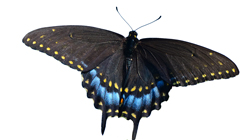
Herbs like dill, fennel, and parsley, along with Queen Anne’s lace, are host plants for the black swallowtail. This butterfly lays a small orange egg on these plants and the caterpillar hatches out about a week later. The caterpillar starts out small and black but will eventually grow to be a beautiful green color with black stripes and yellow polka dots. If you have an herb garden be on the lookout for the eggs and caterpillars before harvesting. Other swallowtail species in the area include the tiger swallowtail, which will lay its eggs on magnolia and poplar trees, and the spicebush swallowtail, which will lay its eggs on spicebush and sassafras trees.
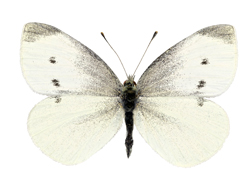
If you grow lettuce, cabbage, or broccoli you may find the leaves being eaten by a small green caterpillar that blends in very well with the leaves. This is the caterpillar of the cabbage white butterfly. This is one of the most common butterflies you will find in our area, and that is because the caterpillar will feed on a variety of host plants, many of which are very common. This butterfly was introduced from Europe in the 1860s and has spread ever since. You can identify males from females in this species: Males have a single black spot on their wings, and females have two.
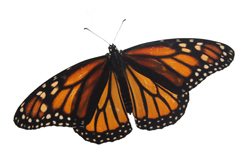
Milkweeds are probably the most commonly planted butterfly plants. Not only do their blooms produce nectar for grown butterflies, but the monarch butterfly relies on milkweed plants, and milkweed plants alone, for survival. Common milkweed, swamp milkweed, and butterfly weed are all milkweed species found in our area. The common milkweed can spread very easily, so butterfly weed and swamp milkweed are the best choices for a backyard. Be on the lookout in your garden for black swallowwort, which occupies the same habitat as milkweed. Monarchs sometimes lay their eggs on it, but the plant gives no nutrition to the caterpillars, so they do not survive. This plant is highly invasive and should be removed if you find it in your garden. It is so invasive that it should be bagged up in a garbage bag and thrown away, never composted.
There are some butterfly host plants that are quite inconspicuous. You may have them already and not know it. False nettle and hops are host plants to the eastern comma and question mark butterflies. These butterflies get their names from a small white marking on their wings which either looks like a question mark or comma depending on the species. Plantain, commonly found among lawns, is a host plant to the common buckeye. Violets, which can grow rampant in gardens, are a host plant to fritillary butterflies, and clover is a host to the clouded sulphur. Oak and willow trees are also common host plants for butterflies, and the very impressive giant silk moths.
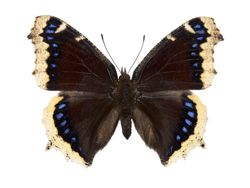
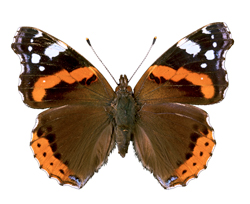
Butterfly feeders, houses, and puddlers are also available to help attract butterflies to a garden. Butterfly feeders hold nectar and fruit. They sometimes look similar to a hummingbird feeder, but the nectar is provided to the butterfly with a wick that goes from the nectar reservoir to the outside of the feeder. Because butterflies have a delicate proboscis, they can’t always dip it straight into a nectar feeder but instead need to dap at a wick or sponge. Butterflies will also eat rotting fruit which can be put on the top of these feeders. Butterfly houses don’t attract butterflies like a bird house would, instead they are used to house hibernating butterflies. Some butterflies, like the mourning cloak, will hibernate as an adult butterfly. This is why on a warm winter day you may see one flying, even with snow covering the ground. These butterflies look for small cervices to wedge into for the winter. A butterfly house can provide this habitat, especially if it is filled with grasses and sticks. Butterfly puddlers probably the best way to attract butterflies to a garden. They can be as simple as a small birdbath or dish, filled with small pebbles, rocks, sand and dirt. They should be kept moist. Butterflies, especially male butterflies, will land on the dish and siphon up minerals from the dirt, sand or rocks. The red admiral, a common migratory butterfly, can often be found exhibiting this behavior.
Nectar-producing plants will attract adult butterflies, bees and also hummingbirds! Some great nectar-producing plants for butterflies include Joe Pye weed, butterfly bush, iron weed, phlox, milkweeds, goldenrod, asters, lantana and coneflowers. Hummingbirds and butterflies will both actively come to blazing star, columbine, cardinal flower, bee balm and salvias.
When planting for butterflies, native plants are always best, plus they require less upkeep. Remember to stay away from pesticides, as they will kill all insects, not just the ones you are trying to get rid of. And, ultimately, messy is good! Gardens that are allowed to grow a little wild are often the best places for butterflies to lay their eggs, pupate and nectar on flowers.
Liz Magnanti is the manager of the Bird House in Pittsford.
Views: 0






